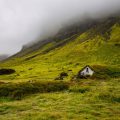1. Understanding the Monsoon: India’s Unique Rainy Season
The Indian monsoon is more than just a seasonal change; it’s a dramatic transformation that shapes the land, culture, and adventure opportunities across the country. Stretching from June to September, the southwest monsoon brings heavy rainfall to regions like the Western Ghats, Himachal Pradesh, Uttarakhand, and the lush landscapes of the Northeast. For trekkers and campers, this means vibrant greenery, gushing rivers, and waterfalls in full flow. However, it also presents challenges such as slippery trails, leeches, swollen streams, and sudden weather shifts. Being mindful of these changes and respecting nature’s rhythm is key to experiencing India’s trekking routes sustainably during this season. Whether you’re navigating misty hills in Munnar or exploring rain-soaked forests near Cherrapunji, understanding how the monsoon impacts each region prepares you for both the beauty and unpredictability of rainy adventures in India.
Eco-Friendly Packing Essentials for Monsoon Trails
Embarking on a monsoon trek across India’s vibrant landscapes means preparing not just for heavy rain and muddy trails, but also for the environmental impact of your journey. Choosing eco-friendly packing essentials is the first step towards responsible trekking during the rainy season. Here’s a guide to sustainable gear, rain protection, and minimalist must-haves tailored specifically for Indian monsoon adventures.
Sustainable Gear Choices
Opt for trekking gear made from recycled or biodegradable materials. Brands available in India like Wildcraft and Decathlon offer backpacks and clothing lines that incorporate eco-conscious fabrics. Avoid single-use plastics—carry a reusable water bottle (preferably stainless steel), and pack meals in leak-proof tiffin boxes. For energy, bring homemade snacks in cloth pouches instead of plastic wrappers.
Monsoon Rain Protection
With unpredictable downpours, waterproofing is essential. Choose a poncho or rain jacket with PFC-free water-repellent coatings; these are safer for the environment and readily available in local markets. Eco-friendly rain covers for backpacks and biodegradable garbage bags are crucial to keep your belongings dry and trails clean. Always pack quick-dry clothing made from organic cotton or bamboo blends, which reduce microplastic pollution compared to synthetic alternatives.
Minimalist Packing Must-Haves
Packing light is key when trekking through slippery, lush Indian paths. Limit yourself to multi-purpose items—think sarongs that double as towels or sheets, and sturdy sandals that work both on and off the trail. To help you plan efficiently, here’s a table of recommended minimalist essentials:
| Item | Eco-Friendly Option | Purpose |
|---|---|---|
| Water Bottle | Stainless Steel / Copper | Hydration & Cooling |
| Trekking Shoes | Natural Rubber Soles | Muddy Trail Grip |
| Rain Jacket/Poncho | PFC-Free Coating | Rain Protection |
| Tiffin Box/Containers | Steel/Glass/Plant-based Material | Packing Meals & Snacks |
| Sarong/Multipurpose Cloth | Organic Cotton/Bamboo Fabric | Towel/Sleep Sheet/Shawl |
| Trash Bag | Biodegradable Bag/Jute Sack | Packing Out Waste |
| Torch/Headlamp | Rechargeable Battery Model | Night Visibility/Safety |
By choosing sustainable gear and prioritising minimalist packing, you not only lighten your load but also contribute to preserving India’s breathtaking monsoon trails for future trekkers. Remember: every eco-friendly choice makes a difference during your rainy adventure.
![]()
3. Safe Trekking Practices During Indian Rains
Respecting the Monsoon: Navigate with Caution
The Indian monsoon is both beautiful and challenging, transforming landscapes but also making trekking trails slippery and unpredictable. Always check local weather updates (IMD advisories or local news) before starting your trek. Avoid venturing out if heavy rainfall warnings are issued. When on the trail, slow down your pace and choose paths with visible footfalls—many experienced trekkers in the Western Ghats or Himalayan foothills will advise following tracks already used by villagers or shepherds, as these are often safer during rains.
Dealing with Slippery Trails
Invest in high-grip, water-resistant trekking shoes commonly recommended by seasoned trekkers from Himachal to Kerala. Use a sturdy bamboo stick—a traditional trekking tool in India—to help maintain balance on muddy slopes. When descending, keep your knees slightly bent and step sideways for better stability. Many local guides suggest walking in single file to minimize erosion and avoid widening delicate trails.
River Crossings: Embrace Local Wisdom
Monsoon swells rivers quickly; never attempt to cross fast-flowing streams alone. Observe locals—many communities use makeshift bamboo bridges or wait for water levels to subside before crossing. If you must cross, unbuckle your backpack so it can be released easily if you slip, and always hold hands or lock arms in a group crossing for added safety. Remember the golden rule: when in doubt, don’t cross.
Staying Healthy on the Trail
The humid monsoon climate breeds leeches and increases risk of infections. Carry neem oil or salt sachets, traditional remedies used by South Indian trekkers to repel leeches. Drink only boiled or filtered water—carry a reusable filter bottle as recommended by eco-conscious trekking groups across India. Consume light, home-cooked food like poha or upma packed in banana leaves (a sustainable practice popular in rural Maharashtra and Karnataka), which stays fresh longer and reduces plastic waste.
Community Practices & Respect
Engage with local villagers for real-time advice on trail conditions—they possess generational knowledge about safe routes and river behavior during monsoons. Always inform someone in the community about your route and expected return time, a custom followed by hill tribes to ensure everyone’s safety.
4. Camping the Indian Way: Green Shelter & Hygienic Stay
When camping during the monsoon in India, embracing eco-friendly practices and respecting local customs is as important as braving the rain. Indian forests and hills, often dotted with sacred groves and spiritual spaces, call for a mindful approach to camping.
Eco-Friendly Camp Set-Up
Choose your campsite carefully—preferably on durable surfaces away from water sources and far from sacred trees or shrines. Use biodegradable tents or tarpaulins and avoid plastic wherever possible. If you’re hiring gear, opt for local brands supporting sustainable materials.
Table: Eco-Friendly Camping Essentials
| Item | Sustainable Alternative | Why Choose It? |
|---|---|---|
| Sleeping Mats | Bamboo/Recycled Fabric Mats | Locally made, bio-based, supports artisans |
| Utensils | Steel/Areca Leaf Plates | Reusable or compostable; no plastic waste |
| Lamps/Torches | Solar-Powered Lights | No batteries; harnesses renewable energy |
| Tent Pegs | Bamboo/Wooden Pegs | Biodegradable and gentle on soil |
Responsible Waste Management
The golden rule: “Leave No Trace.” Carry reusable garbage bags (jute or cloth) to segregate wet and dry waste. Compost food scraps where safe, but never leave litter behind. Take all non-biodegradable items back to town for proper disposal—this includes snack wrappers and sanitary products.
Waste Segregation Chart for Campsites
| Type of Waste | Disposal Method |
|---|---|
| Food Waste (Vegetarian) | Bury in a small pit, away from water sources; cover well. |
| Plastic & Foil Packaging | Pack out in a sealed bag; dispose at urban collection points. |
| Papers & Tissues | If clean, burn in campfire (where allowed); else pack out. |
| Sanitary Products & Wet Wipes | Packed separately; do not bury or burn—dispose in city bins. |
Cultural Sensitivity: Sacred Groves & Local Traditions
Sacred groves (“devara kaadu” in Karnataka or “kavu” in Kerala) are protected by local communities for religious reasons. Always seek permission before entering such areas, avoid loud music or alcohol, and never disturb prayer stones or offerings. Greet locals with a respectful “Namaste” or “Vanakkam,” and follow their advice about safe zones and prohibited spaces.
Sustainable Camping Mantras for India’s Monsoons:
- Tread softly—stick to existing trails and campsites.
- Cherish the quiet—nature here is revered as Mother Earth (“Bharat Mata”).
- If offered chai or prasad by villagers, accept humbly—it’s part of the local hospitality spirit.
- Share your eco-practices with fellow trekkers to inspire collective responsibility.
By blending green camping techniques with cultural respect, your monsoon adventure becomes an example of true Indian hospitality and environmental stewardship—leaving both the land and its traditions thriving for generations to come.
5. Savory Monsoon Meals: Indian Camping Food Guide
After a long trek through the lush, rain-drenched landscapes of India, a comforting meal can rejuvenate body and spirit. Monsoon camping calls for warming, easy-to-cook vegetarian dishes that celebrate local flavors and are gentle on the environment. Here are some practical ideas to keep your meals nourishing, light on waste, and full of regional character.
Quick & Hearty Vegetarian Dishes
Poha (Flattened Rice): A staple across Maharashtra and Madhya Pradesh, poha is lightweight to carry and cooks quickly with just hot water. Add peanuts, curry leaves, turmeric, and green chilies for an aromatic breakfast or snack.
Khichdi: This classic mix of rice and lentils is perfect for rainy nights. It’s soothing, filling, and can be enhanced with seasonal vegetables like carrots or beans. Use minimal oil and bring along homemade masala for extra flavor.
Thepla/Paratha: Gujarati methi theplas or plain parathas travel well and pair beautifully with pickle or curd. They make a satisfying lunch after a morning trek.
Regional Touches: Local Flavours on the Trail
If trekking in South India, consider lemon rice or curd rice, both simple to prepare and cooling for humid afternoons. In Himalayan regions, try Aloo Jeera (spiced potatoes) with roti—easy to cook over a camp stove.
Packing Tips for Eco-Friendly Cooking
- Choose reusable containers and steel plates to minimize single-use plastics.
- Opt for dry ingredients like dal, rice, spices, and dehydrated veggies to reduce spoilage.
- Carry your food scraps out; compost them where possible.
The Perfect Monsoon Chai
No monsoon experience is complete without chai! Brew a pot using Assam or Darjeeling tea leaves, add ginger (adrak) and cardamom (elaichi) for warmth. For extra comfort, toss in tulsi leaves or lemongrass if available locally. Enjoy by the campfire as you watch the rains roll over the hills.
Sustainable Practices for Camp Cooking
- Use locally sourced ingredients whenever possible to support communities.
- Avoid packaged snacks; instead, prep homemade trail mixes with nuts and dried fruits.
- Always douse your cooking fire properly with water to prevent wildfires in forested areas.
Savoring simple, regional vegetarian meals not only keeps you energized but also deepens your connection to India’s diverse culinary traditions while treading lightly on nature during your monsoon adventure.
6. Supporting Local Communities & Nature
Mindful Tourism: Respecting People and the Environment
Monsoon trekking in India is not just about exploring lush landscapes; it’s also an opportunity to uplift local communities and protect nature. Mindful tourism encourages travellers to act consciously, leaving a positive impact on the places they visit. Here are some simple ways to support both people and planet during your rainy season adventures.
Buy Local, Support Local
Opt for local snacks, handicrafts, or trekking essentials from village shops or roadside stalls. Not only will you get authentic products—like rain shields or homemade chai—but you’ll also help sustain small businesses. Bargain respectfully, remembering that every rupee spent supports a family.
Choose Public Transport and Shared Rides
Using public buses or shared jeeps to reach your trekking base reduces carbon emissions and traffic congestion in delicate hill regions. It’s budget-friendly, eco-friendly, and offers a chance to interact with locals. If you must hire a cab, try to carpool with fellow trekkers.
Tread Lightly: Leave No Trace
Respect the trails by sticking to marked paths and avoiding shortcuts that erode soil. Carry reusable water bottles and snack boxes to minimise plastic waste. Pack out all your litter—even biodegradable items—and encourage others to do the same. Remember, preserving these beautiful monsoon landscapes ensures they remain vibrant for future generations of trekkers.
A Simple Act Makes a Big Difference
Your small, conscious choices—buying local, reducing waste, and respecting nature—help nurture both communities and the environment. As you trek through misty forests or camp beside gushing rivers this monsoon, let sustainability guide your journey for a more meaningful adventure in Incredible India.


